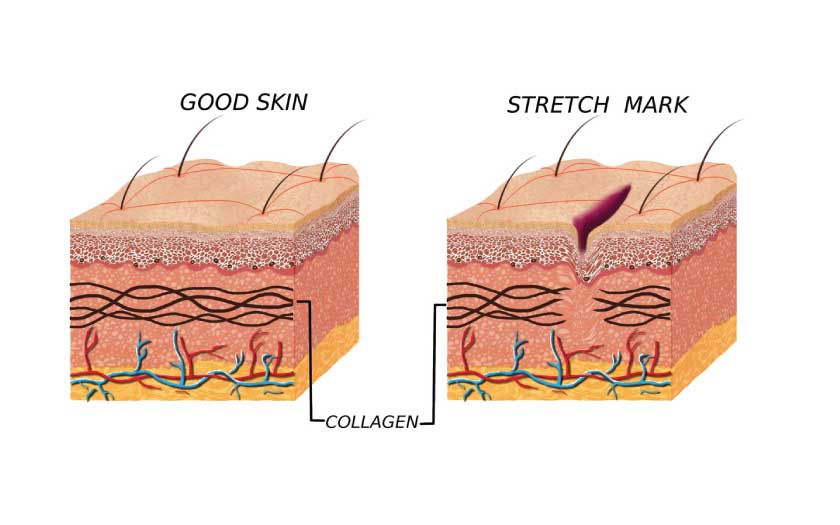Stretch marks are hard to ignore, especially if you happened to have smooth, scar-less skin before pregnancy. If you have stretch marks or wish to prevent them, this article is for you.

What causes them?
Stretch marks are what you get when the dermis (the middle layer of the skin) goes through some major, continuous stretching, such as during pregnancy. Collagen plays a part too, where the lack of it may cause the skin to break down instead of snapping back into shape. This results in scarring.
In most cases of stretch marks, the blood vessels tend to dilate when it happens, causing the reddish or purple color when the marks first appear. In time, the marks get lighter or even white or silverish due to the loss of pigment-producing melanocyte cells in the affected area.
Stretch marks are also found to be connected to hormonal changes — a norm during puberty and pregnancy. The same goes for those involved in weightlifting. It takes place when the adrenal glands are excreting increased amounts of glucocorticoids, which stop inflammation but at the same time impede collagen and elastin fiber formation. During these periods when the skin is being stretched to accommodate a growing belly during pregnancy or bulging muscles due to lifting heavy weights, etc, the dermis isn’t able to generate enough supportive material to keep up and ends up tearing.
Lastly, does your mother have stretch marks? If she does, chances are you will get them too, for it may be a genetic issue.
Leave it or treat it?
That’s really up to you and where you stand in this matter. Some moms consider these marks the most honoured badge of their motherhood and they wear them with pride. If you do not mind them being part of your post-baby body, then there’s no reason to not leave them be!
If however, they do bother you, we’d like to remind you that present marks may be able to fade out with proper care, but they can’t possibly be diminished completely without invasive procedures such as laser treatments or plastic surgery.
If you have prevention or even elimination of these marks in mind, we’re ready to help you — keep in mind though that prevention is still better than cure.
The best way to go about this is to start from the inside out, for, after all, you (and your skin!) are what you eat. So, if you don’t think your diet plays a role in this, you’re in trouble. Next will be to pamper your skin with proper skincare.
Eat right for your skin
To promote strong, healthy skin from the inside out, it’s important to pay attention to what you’re putting into your body. Foods rich in Vitamins A, C, and E, as well as zinc and protein, are a must for aiding in cell regeneration and in maintaining collagen fibres. Just as important is keeping your skin well-hydrated from within too, with lots of water. You’ll also need enough water to aid in digesting all those nutrients or they may not even be of any help at all in keeping stretch marks at bay!
Here are some examples of skin-saving nutrients to help you get more of them into your body.
Vitamins A, C, and E
Vitamin A protects against UV damage and helps build more collagen. Most of our vitamin A intake comes from eating foods rich in beta-carotene and provitamin A carotenoids, which are potent antioxidants that encourage healthy skin cell production and renewal. Examples of foods that are rich in Vitamin A are beef liver, carrots, sweet potato, spinach, and kale are highest in this vitamin.
Vitamin C is a powerful skin-loving nutrient. As an antioxidant, it is used to fight off toxins known as “free radicals” that interfere with skin healing including the fading of stretch mark scars. Foods rich in Vitamin C include oranges, cantaloupe, bell peppers, papayas, pineapples, and strawberries.
Vitamin E is one of the top vitamins that is said to be highly effective at preventing and treating stretch marks associated with pregnancy or weight gain. This is due to this nutrient’s ability to help the body regenerate new and stronger skin cells at the deepest level. That’s why it’s found in most products that are meant for treating stretch marks. Consuming foods rich in Vitamin E will also be helpful for some much-needed repairing aid from within. Foods rich in Vitamin E include whole grains, nuts, sunflower seeds, almonds, and avocados.
Zinc & Protein
Did you know that zinc deficiency is very common in women? This underrated nutrient plays an integral role in healing and repairing injuries to the skin, which include stretched out skin. You can increase your zinc intake with foods such as lamb and poultry, free-range beef, oysters, spinach, mushrooms, and nuts.
Protein is needed for collagen production, so a protein-rich diet will help if you’re seeking to treat stretch marks, or if you’re trying to avoid it. Protein-rich foods include eggs, beans, dairy products, soy and soy products, fish, poultry, and red meat.
Pamper your skin
When managing stretch marks, you can never go wrong with nourishing and moisturising care.
Products are a-plenty but do pay some attention to what the product is made of, i.e. its ingredients.
Going organic in your skincare regime will go a long way in maintaining healthy, glowing skin without compromising your pregnancy health — It’s a fact that anything applied to the skin will absorb into your bloodstream. By using organic products, you will be avoiding chemicals, pesticides, artificial fragrances, dyes, etc.
You might also need to use less of the product compared to a conventional version. If you happen to be interested in a conventional stretch mark treatment product, one simple trick is to check the label for any ingredient that sounds too complicated or difficult to pronounce — these are usually chemicals that your skin can do without.
Instead, how about reaching out for truly pure and natural ingredients to care for your skin? These ingredients can be either from fresh plant sources or in powder or oil form — they’re way better to use on your skin since there are no chemicals involved. Ingredients such as eggs, aloe vera, milk powder, vitamin E capsules, coconut oil, lemon juice as well as turmeric powder have been known to produce satisfactory results when it comes to treating stretch marks. You can mix your selected ingredients into a paste and smear it onto affected areas and leave it on for a few minutes before rinsing it off. As with any DIY treatments, diligence is the key to achieving any results.


